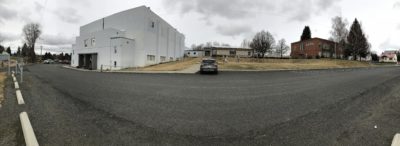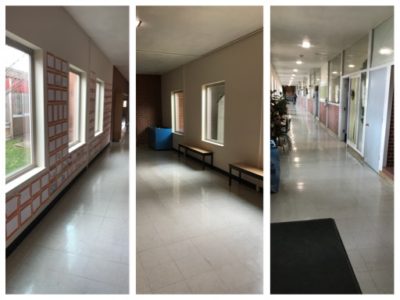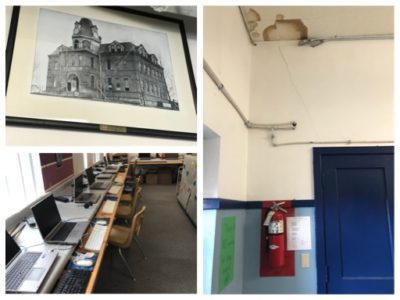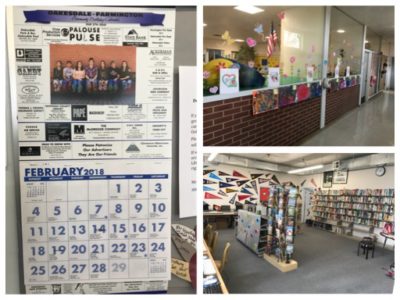 All persuasive arguments begin with a story. That’s exactly what I was greeted with during my first “Teacher of the Year” school visit to Oakesdale elementary, middle and high school. Upon my arrival, Superintendent and Principal, Jake Dingman, immediately took me on a tour of the newly renovated building. I use the term, renovated, loosely, as the changes and additions are merely upgrades to an old foundation. You see, the Oakesdale school house was built in the early 1900’s and the last time the windows in the hallway were replaced was in 1956. They were single-pane, floor-to-ceiling, and in the last several years, they’d begun to leak during bouts of rain or snow. Over the years, the leaks worsened and students simply understood that they had to do their best to walk around the puddles flooding their hallways. Finally, one of the walls of windows collapsed altogether.
All persuasive arguments begin with a story. That’s exactly what I was greeted with during my first “Teacher of the Year” school visit to Oakesdale elementary, middle and high school. Upon my arrival, Superintendent and Principal, Jake Dingman, immediately took me on a tour of the newly renovated building. I use the term, renovated, loosely, as the changes and additions are merely upgrades to an old foundation. You see, the Oakesdale school house was built in the early 1900’s and the last time the windows in the hallway were replaced was in 1956. They were single-pane, floor-to-ceiling, and in the last several years, they’d begun to leak during bouts of rain or snow. Over the years, the leaks worsened and students simply understood that they had to do their best to walk around the puddles flooding their hallways. Finally, one of the walls of windows collapsed altogether.
 Superintendent Dingman and his staff worked for several years to pass a bond, to renovate the school, but to no avail. He informed me that rural folks don’t like to carry debt and bonds can last from 20 to 25 years. It wasn’t until Dingman tried for a capital levy that he was able to make some updates to the building. He was quite proud of the new walls and windows in the hallways. To most visitors these updates wouldn’t seem like much, but to Dingman and the students and teachers in Oakesdale, they meant freedom of movement and warmth during cold months.
Superintendent Dingman and his staff worked for several years to pass a bond, to renovate the school, but to no avail. He informed me that rural folks don’t like to carry debt and bonds can last from 20 to 25 years. It wasn’t until Dingman tried for a capital levy that he was able to make some updates to the building. He was quite proud of the new walls and windows in the hallways. To most visitors these updates wouldn’t seem like much, but to Dingman and the students and teachers in Oakesdale, they meant freedom of movement and warmth during cold months.
The high school, on the same campus as the elementary-middle school, was built in 1936. There was a remodel in 1970, which covered up the beautiful wooden floors with tile squares, but little has been done since. The plumbing is on the outside of the walls, because the old pipes located beneath the building have corroded to the point of uselessness. Needless to say, both buildings are still in need of major renovation.
 Beyond the actual buildings, Oakesdale also lacks technology. The district currently contracts with the prison to purchase computers. Inmates refurbish the units, the district buys them at a minimal cost, then they add additional RAM and programs to make them usable. With the passing of their most recent capital levy, along with additional renovations, they plan to purchase Chromebooks for the high school. The computer science teacher is very excited.
Beyond the actual buildings, Oakesdale also lacks technology. The district currently contracts with the prison to purchase computers. Inmates refurbish the units, the district buys them at a minimal cost, then they add additional RAM and programs to make them usable. With the passing of their most recent capital levy, along with additional renovations, they plan to purchase Chromebooks for the high school. The computer science teacher is very excited.
Oakesdale‘s story is not uncommon in rural areas. Often these towns struggle to pass levies and bonds because they not only count on the voters in their town, but also on voters in neighboring towns, who may not have children attending their school. Additionally, Dingman explained, the restrictions on the use of levy dollars through House Bill 2242 during the 2017 legislative session will also have a drastic impact on his school, as he may be faced with losing $300-400,000 due to levy equalization. This is particularly interesting, as equalization was intended to benefit small rural districts.
I think it’s important to briefly explain the differences between a bond, an enrichment levy, and a capital levy.
– A bond is a debt, meaning, the school district borrows money from investors and uses that money for capital projects, such as construction projects, renovations, or vehicle/equipment purchases. The bond is paid back over an extended period of time, usually over 20 to 25 years, with interest. It requires a vote by the people and must pass by 60%.
– An enrichment levy is funded through a property tax during the life of the levy, usually 3 years. It covers curriculum, programs, extracurricular activities, and anything else that falls under the broad umbrella of enrichment in a school district, but may not be used for capital assets, like building updates or maintenance. Many school districts have also used these funds to pay Paraeducators and some classroom teachers, but this is no longer allowed under HB 2242. This type of levy requires a vote by the people and must pass by 50%.
– A capital levy is also funded through a property tax during the life of the levy, usually 3 years. This levy covers acquiring, maintaining, or improving capital assets like a school building or technology solutions. It does not cover new construction or full renovations, as the funds are not adequate for such large projects. This type of levy also requires a vote by the people and must pass by 50%.
School funding is tricky. It is important to understand how legislation impacts all areas of our state, as each district has different needs. A bill, as passed by the legislature, may not do what it originally intended. We must remember that bills, even when passed, are not set in stone. I am looking forward to seeing the changes that come out of this legislative session in an effort to adjust HB 2242 to what the legislature intended, a true fix in providing funding equity for all districts.
 While Oakesdale is a great example of the challenges small rural districts face in remodeling and renovating their schools and in acquiring adequate technology (including access to high-speed wifi), it is also a great example of the benefits of a small community. Class sizes are small, and teachers really know ALL of their students. There is even a community calendar that highlights important dates for every member of the community down to anniversaries and birthdays. Individualized instruction is attainable and implemented. It’s also clear that Principal Dingman and the eductors are proud of their school and love to be there. It’s super cool to see.
While Oakesdale is a great example of the challenges small rural districts face in remodeling and renovating their schools and in acquiring adequate technology (including access to high-speed wifi), it is also a great example of the benefits of a small community. Class sizes are small, and teachers really know ALL of their students. There is even a community calendar that highlights important dates for every member of the community down to anniversaries and birthdays. Individualized instruction is attainable and implemented. It’s also clear that Principal Dingman and the eductors are proud of their school and love to be there. It’s super cool to see.
There are challenges and benefits to every size school district. Being Teacher of the Year has afforded me the opportunity to see them firsthand and to share them with others. What are some of the challenges and benefits in your district? Share them in a comment below.
Your community has an amazing culture. When a neighbor is in need, community culture rises. The same culture can stand in the way of the future. Example, few churches in the Palouse have grown much in your area over my lifetime. That is culture and culture trumps everything. The old folks that control the purse strings in their Churches and Schools must stand, face a mirror and ask themselves, what are they actually contributing to their communities future?
Many of the same farmers voting down levy proposals, are the same farmers that were given their farm. Their parents payed it forward, and in many cases were extremely generous to their children. That was the generation with a vision and a whole lot of GRIT, bought and paid for the farm and built the schools so their children could have it better than they had it. They forgot to pass “Vision and Grit” on to their grandchildren.
Start working on your “Community Culture” and it may just save your school for another generation. Heck your school district might even thrive. God Bless You:
Daniel. 2:22-23
I attended and graduated from Steptoe Elementary in 1958, most of that time I spent at the bottom of my class.
Thank you for your thoughts on my post, Daniel. I agree that community members need to assess their own contributions to their communities, and also the contributions the schools make to their communities. I appreciate your thoughts.
Hi Mandy,
Wow-do I know your struggle well. Our building was built in 1913 with a major upgrade of a gym in the 1930s. Since that time, not much was done to it at all. About ten years ago, we had to scramble to get in some new doors, etc to meet new fire codes. It was hard to get money to do so, even with the knowledge the school would be shut down without these.
About five years ago, we received massive grant dollars to overhaul the entire building-took it down to the studs so to speak. Millions of dollars granted to our community-not a penny from the community. For us, the biggest struggle was the fight against change. The school had been in operation for such a long time that the people could not readily bring themselves to embrace the change. In some ways, they loved the school (or their memories of being there) too much to see it any differently.
Time has marched forward. The school renovation has been completed. It is now a joy to see people stop in for a visit and marvel at what all has been done. The memories are still there, with a clean and open space to make new ones.
Thanks for addressing this topic. Love our rural schools!
Gretchen
Thank you for your comment, Gretchen. Your school’s struggles, as well as those of Oakesdale, are common, as I’ve been hearing through my travels. I am curious, where did your grant funding come from?